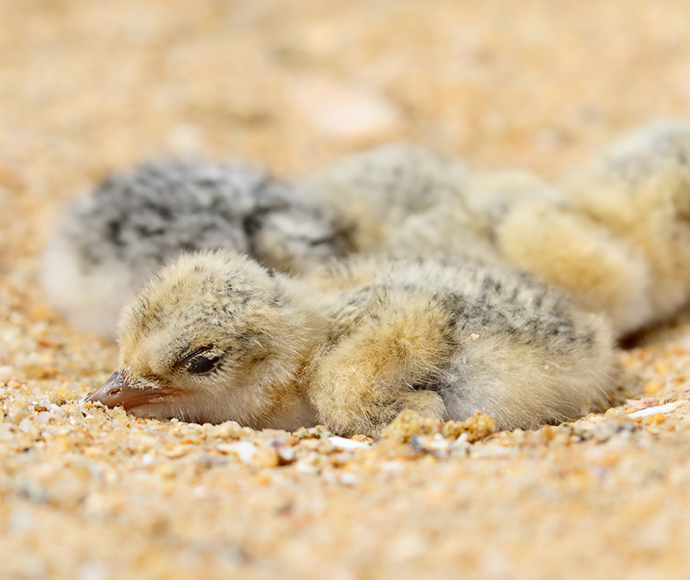Watch your step because threatened shorebirds are nesting a little early this year on Port Stephens’ sandy shores.

NSW National Parks and Wildlife Service (NPWS) Threatened Species Officer Katherine Howard said pied oystercatcher eggs have already been found at Port Stephens, which is a key breeding area.
‘Endangered pied oystercatchers and little terns lay eggs in shallow scraped-out nests on beaches and sandy shores,’ Ms Howard said.
‘There are only around 450 nesting pairs of little terns in New South Wales, with the breeding population declining 2.6% each year from 2001 to 2020.
‘There are even fewer pied oystercatchers, which seems surprising as they are a distinctive shorebird and regularly seen, but there are less than 200 breeding pairs in New South Wales.
‘We need to share the shore with these beautiful birds and give them the space they need to raise their families.
‘Shorebird eggs and chicks camouflage so well against the sand they are almost invisible and very easy to inadvertently step on or drive over.’
NPWS and its partners protect threatened beach-nesting birds by managing predators and preventing disturbance or accidental crushing by beach users, vehicles and dogs.
People are asked to keep away from nesting areas marked by signs or fences, always follow the local beach driving rules and only take dogs to designated dog beaches.
‘Chicks don’t necessarily stay within marked nesting areas, so we can reduce the risk of accidentally stepping on a chick by keeping to the wet sand,’ she said.
Shorebirds nest on sandy beaches right along the NSW coastline, including Corrie Island Nature Reserve, Winda Woppa peninsula in Hawks Nest and the Worimi Conservation Lands.
Nest sites may be fenced or signed, while parts of some beaches, such as Corrie Island’s, will be entirely closed to visitors during the breeding months from August to March, to allow these birds space and peace to raise their families.
Visitors are reminded that dogs are not allowed in any NPWS parks, including Corrie Island Nature Reserve.
Protection and monitoring of beach-nesting birds in Port Stephens is delivered by the NSW Government’s Saving our Species program, NPWS, Biodiversity Conservation Division, MidCoast Council and volunteers from the Myall Koala and Environment Group. It is supported by Hunter Local Land Services through funding from the Australian Government’s National Landcare Program.
Feathered facts
- Endangered little terns migrate thousands of kilometres from eastern Asia to lay their eggs on Australian beaches every summer, usually arriving on NSW beaches between September and November.
- At less than 25cm long, they are the smallest terns in New South Wales.
- They have ‘black caps’ over white feathers with pale-grey wings.
- Pied oystercatchers are distinctive, black-and-white shorebirds with pink legs and red beaks. Almost always seen in pairs, they live in Australia year-round, and usually start nesting in August or September.
- ‘Oystercatcher’ is bit of a misnomer, as this species eats many other invertebrates, as well as oysters and other bivalve molluscs.
- Eggs of beach-nesting birds are speckled and blotched to provide camouflage but are still at risk of predators both on the ground and from the air. Predators of shorebird eggs include foxes, dogs, dingoes, ravens, silver gulls, and goannas.
- Beach-nesting birds lay their eggs in shallow scrapes in the sand, often on estuary entrance bars up and down the coast.
Four steps to help keep shorebirds safe
- Look out for bird nesting signs or fenced-off nesting areas on the beach, stay well clear of these areas and give the parent birds plenty of space.
- Walk dogs only on designated dog-friendly beaches and always keep them on a leash over summer.
- Drive only on designated vehicle beaches, stay out of nesting areas and follow all local beach-driving rules.
- Chicks are mobile and don’t necessarily stay within fenced nesting areas. Stick to the wet sand to avoid accidentally stepping on a chick.








